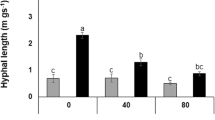Abstract
High salt levels in soil and water can limit agricultural production and land development in arid and semiarid regions. Arbuscular mycorrhizal fungi (AMF) have been shown to decrease plant yield losses in saline soils. The objective of this study was to examine the growth and mineral acquisition responses of greenhouse-grown tomato to colonization by the AMF Glomus mosseae [(Nicol. And Gerd.) Gerd. and Trappe] under varied levels of salt. NaCl was added to soil in the irrigation water to give an ECe of 1.4 (control), 4.7 (medium) and 7.4 dS m–1 (high salt stress). Plants were grown in a sterilized, low P (silty clay) soil-sand mix. Mycorrhizal colonization was higher in the control than in saline soil conditions. Shoot and root dry matter yields and leaf area were higher in mycorrhizal than in nonmycorrhizal plants. Total accumulation of P, Zn, Cu, and Fe was higher in mycorrhizal than in nonmycorrhizal plants under both control and medium salt stress conditions. Shoot Na concentrations were lower in mycorrhizal than in nonmycorrhizal plants grown under saline soil conditions. The improved growth and nutrient acquisition in tomato demonstrate the potential of AMF colonization for protecting plants against salt stress in arid and semiarid areas.
Similar content being viewed by others
Author information
Authors and Affiliations
Additional information
Accepted: 21 February 2000
Rights and permissions
About this article
Cite this article
Al-Karaki, G. Growth of mycorrhizal tomato and mineral acquisition under salt stress. Mycorrhiza 10, 51–54 (2000). https://doi.org/10.1007/s005720000055
Issue Date:
DOI: https://doi.org/10.1007/s005720000055




